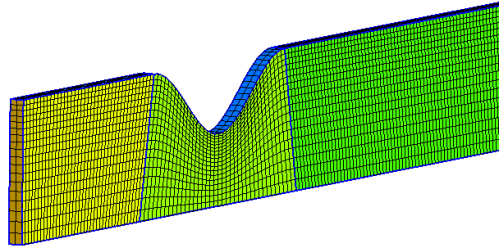
1st order meshes cannot be optimized because their element borders are linear an cannot be deformed. Elastic is an algorithm in which the mesh elements are treated as a collection of deformable viscoelastic solids. Introduced in version 0.20 Gmsh supports different optimization algorithms. The optimization is done by a deformation of the element borders. Data High Order Optimize: If and how meshes with Data Element Order = 2nd are optimized.So all surfaces of this region will form one physical group. For example a mesh of the same object region is internally tagged the same. They and are identified by their dimension and by a tag. Physical groups are collections of mesh entities (points, curves, surfaces and volumes). Data Groups Of Nodes: All nodes and not only the elements will be saved for each physical mesh group.

The default 0.0 means that Gmsh's default of 1e-8 is used. Data Geometrical Tolerance: The geometrical tolerance for the mesh to match the object edges.This property can also be changed in the Gmsh dialog in the field Mesh order. Data Element Order: The mesh element order.From Shape (default) the dimension will be determined from the dimension of the object that is meshed.This property can also be changed in the Gmsh dialog in the field Mesh element dimension. Data Element Dimension: The dimension of the mesh elements.true (default) duplicate mesh nodes will be removed.This property can also be changed in the Gmsh dialog in the field Min element size. If set to 0.0, the size will be set automatically. Data Characteristic Length Min: The minimal size of the mesh elements.This property can also be changed in the Gmsh dialog in the field Max element size. Data Characteristic Length Max: The maximal size of the mesh elements.The different algorithms are explained here. Data Algorithm3D: The algorithm to create 3D meshes.For Delaunay, see Delaunay triangulation. Data Algorithm2D: The algorithm to create 2D meshes.(You can leave the dialog open while changing properties.) After you changed a property, you must reopen the Gmsh dialog again and click the Apply button. You now should see a new FEMMeshGMSH object in your active analysis container.Īfter the mesh has been crated you can change its properties using the property editor. Click the Apply button and wait for the computation of the mesh to complete.(Autodetection works fine unless you apply complicated boundary conditions.) Optionally edit the minimal and maximal element size.



A compsolid is necessary if your part is made from multiple materials. For volume FEM this needs to be a solid or compsolid. This command uses the program Gmsh (which needs to be installed on the system) for calculating the mesh.ĭepending on your operating system and your installation package Gmsh might be bundled with FreeCAD or not. For a finite elements analysis the geometry needs to be discretized into a FEM Mesh.


 0 kommentar(er)
0 kommentar(er)
